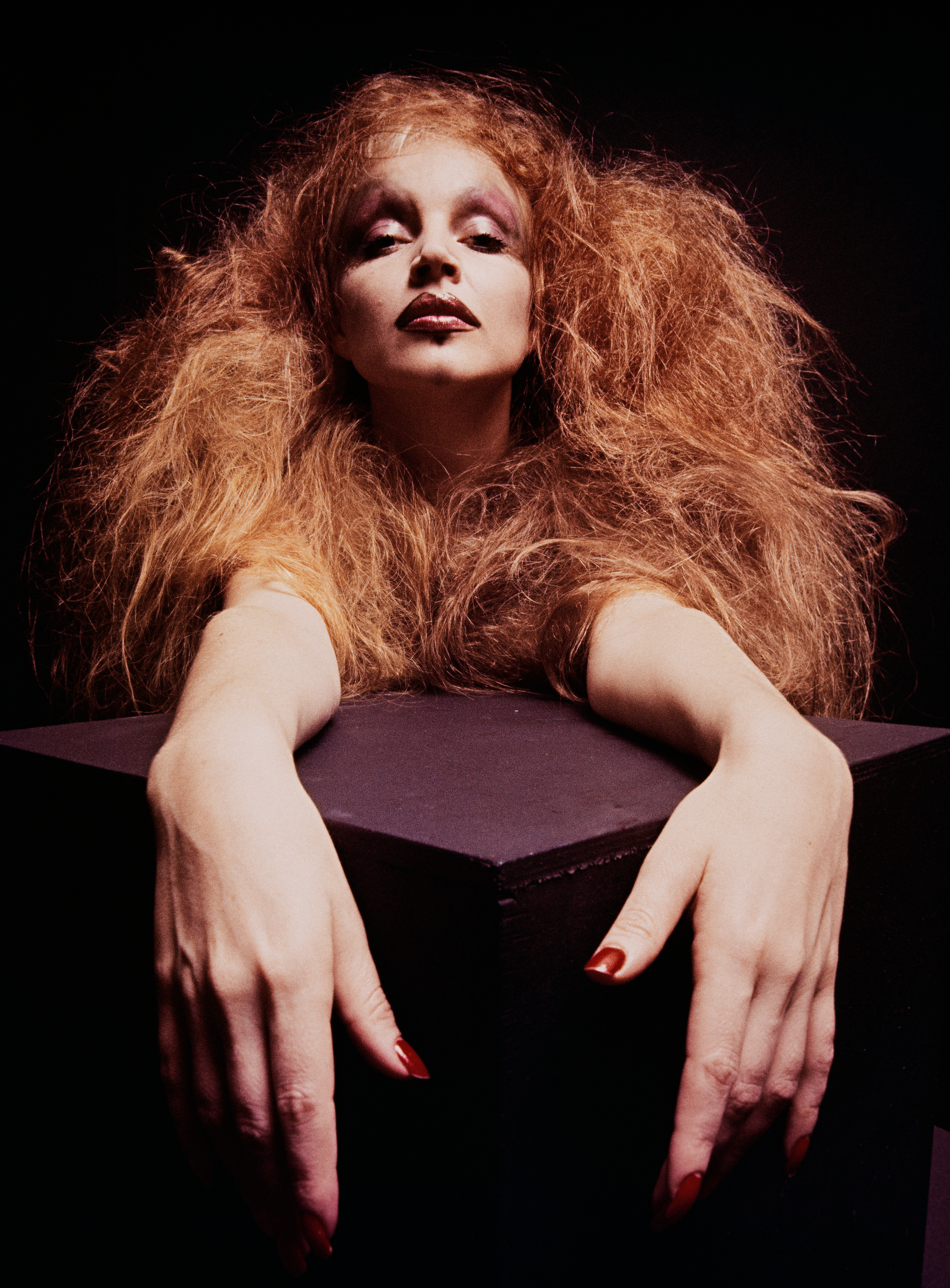
Exhibition
ELKE
17 May to 19 November 2022
ELKE – sacred, profane, holy, devil
“The important thing is to be born and die, the rest is a sausage that we fill up, taking care not to fill an indigestible sausage.”
Elke Wonder
Who knows that he will die, would deceive death in life. Wave, say good morning and see you tomorrow. The meeting is inevitable. It imposes the fate of choice, of freedom and of the naked body. There are those who dance with her during lightning moments that put us in contact with the world and with ourselves. At the exact and congruent point of the possible shock, the maximum experience arises: it is when the unfathomable part of life emerges, vertical axis in the face of the horizontality of the stopwatch. We dance with death when we make art to invent and twist everyday life, when we play, when we dress, when we put on makeup, when we sacralize and profane altars, when we organize the lines of everyday life and delimit the outline of the arena in which the tragic crisis of the revelation that one dies every day little.
In order to deny the lifeless body, it is necessary to find this point of tangency between things, aim at the reflection and accept the “revealing facts”, which, as Michel Leiris says, “clarify obscure parts of ourselves, insofar as they act out of a kind of sympathy or similarity, and whose emotional force derives from being mirrors that hold (…) the very image of our emotion”. Accepting the dark part that reaches us is the only possibility of real awareness about our place in the balance of renewal that exists between opposites – life and death, good and evil, good and bad, sacred and profane, male and female. This balance maintains the flow necessary for the creation of meanings and gives those who know about death the power of ethical judgment over things. The gap between the extremes is like a battlefield, where we intend and signify life; where we commute from our conception.
This is how the girl born in Leningrad, in the war year, on February 22, 1945, came into existence: Elke Georgievna Grunupp, Elke Grunupp, Melissa Vassiliki, Elke Evremidis… Elke Wonder. She was Russian, German, Mongolian, Minas Gerais, white, black, red, purple, smooth, curly, beaded, blonde, brunette from everywhere and nowhere. Each day, a new Elke, another, an unknown, but always Elke, tragic; only Elke – unique, for sure. Impermanence, and not indefinition, generated love and hatred from those who watched it on TV; or on the street, from those who were confronted with their own desires. Elke proposed the meeting and, face to face, revealed what we are in the unfathomable.
He received spit in his face. She was called a man, a woman, a transvestite, a witch, a queen, a curse, excessive, extravagant, rebellious. It chose the things it was, accepted the balance of various worlds and thus escaped the restricted definitions. He found the tangency, the mirror of the other. He rejected wealth. She was godmother of the poor and oppressed, children to whom she always gave full marks. Feel kissed and devastated, I said. She was a saint of the street sweepers, the Hansen’s, the sex workers, the prisoners, the homosexuals, the elderly. He chose wholeheartedly the causes he supported knowing that, from the heart, in practice, the effort for good becomes political, out of the sea of ideologies and pamphlets. Who is in the world is the world where everything fits. We are all everything, Elke said, saints, hell, good, bad… what we choose is what is revealed. In a great step as a master, Elke danced with death and instituted an innovative aesthetic, present in everything he created, from the house to the stage. He gave precise and aware form to the ethics he proposed – an incomplete Elke way of thinking and being in the universe, precisely to make room for the necessary polysemy that the ballet of affections demands.
Elke toured the world and herself. He practiced the eternal “bullfighting beauty pass”, about which Leiris talks [1]: Dionysian, antagonistic, deviant, ambiguous, cunning, serious for himself and for the other. He went further: now bull, sometimes bullfighter, he instilled the tragic in everything he did. It carried within itself the burden of danger essential for the experience to be consolidated as such. He found the gap and filled it – here the movement is possible. Whether at fashion shows, when she was the only one to smile gorgonically on the catwalks (whoever smiles knows of death), vivifying the walking of a mannequin; whether by the honks emitted by the Chacrinha duck, or the controversial 10 marks presented to the worst freshmen for the fury and lack of control of Silvio Santos; in dress, in the cinema, in the theater, in the risk taken on the streets, in nightclubs, in relationships, in laughter, where the gap passed opened like lips open: being from another time, another world, another.
And what constitutes this loophole? What defines the Elke ethic of being? What is bequeathed to us? Elke chose the priesthood of friendship, turning everything upside down. He recited his wish at four corners, through several mouths. He ate, swallowed, and regurgitated an entire set table. In a poem dear to the artist, Álvaro de Campos, one of Fernando Pessoa’s heteronyms, said:
Feel everything in every way
To experience everything from everywhere,
To be the same thing in every possible way at the same time,
Realize in yourself the whole of humanity at all times
In a single diffuse, profuse, complete and distant moment
In these verses, there is the dimension of the impossible, and in front of it, the sacrifice. The appeal to the joyful breadth of life carries with it the need to make the things we touch sacred – to understand the dimension that must be set aside, to understand the flaw as a religion, in the sense of rereading to delimit separation, giving the other, space to enter and take possession, since through circumspect, the other gives us property and reveals our being. Just as the son is the one who characterizes the father, even though he is never the father, the other is the one who allows us to be in the world. We die so that the other will be born and, by revelation, we will come to light together. We sacrificed to appease the neighbor/inner god, and return to the profane use of relationships. “Friendship”, says Agamben when analyzing Aristotle’s Nicomachean Ethics, is “the de-subjectivation at the heart of even the most intimate sense of self” [2], in other words, the friend, for this purpose, must be a sacrificed part of our own being within the field of the co-division of one’s own existence. “And it is this objectless sharing”, Agamben continues, “that original consent that constitutes politics” at its origin. For this reason, Elke was the guardian of the good politics of living; she understood the importance of friendship as a weapon and never tired of prophesying: To live is not enough, the important thing is to live with; to live with.
Elke preached love. He put love into everything he did. He distributed love to everyone he met. Aware that we are only ready to die, because there is no escape, he distilled his maxim as an instrument to fill the sausage of life: Eros Anikate Mahan, love is invincible in battle – a verse stolen from the choir of Sophocles’s Antigone, which sentences those who love what is most alive [1], uncertain, risky, and humane.
The exhibition that we offer the visitor is not biographical. Elke stated that biographies should be intended only for great men – Alexander the Great said. Thus, he accepted the sun on his forehead, evading the categorizations intended for the common, revealing what it seems but is not. She lived all things from the concrete of life and symbolized them through the thought that was the fruit of experience – she masterfully controlled the field of representations. Thus, the ensemble is a homage and a thank you for what Elke Maravilha bequeathed to us in various fields of human creation: in fashion, in clothing, in mass and popular culture, in theater, in everyday life, but mainly for teaching us how to transform gold into straw, despite any certainty.
[1] LEIRIS, Michel. Bullfighting Mirror. São Paulo: Cosac and Naify, 2001. “In the bullfighting pass, in short, the bullfighter, with his calculated evolutions, his science, his technique, represents the superhuman geometric figure, the archetype, the Platonic idea. This entirely ideal, timeless beauty, comparable only to the harmony of the stars, is related to contact, friction, and constant threat with the catastrophe of the bull, a kind of monster or a foreign body, which tends to rush, in spite of all the rules, like a dog knocking down a bowling game so aligned with platonic ideas. But even so, we would have only contrast, opposition, if the pass itself were not a kind of tangency, an immediate controversy, followed by a divergence (rapprochement of the bull and the bullfighter; then the separation of man and animal, for which the cloth indicates the “way out”). Except that contact, at the very moment in which it is going to take place, is avoided by a hint, a deviation imposed on the bull’s trajectory, or an avoidance: a slight detachment from the man, a simple torsion of the body, a kind of commitment to which he forces his coldly geometric beauty, as if there were no way to avoid the harm of the bull, other than by partially incorporating it, by imprinting on the person himself something slightly sinister or, to play with words, to misrepresent himself
.”
[2] AGAMBEN, George. Nudity. Belo Horizonte: Authentic, 2015
.
[3] Elke drew attention several times to one of the etymologies intended for the word love, from the Latin a-mors, absence of death. It is also linked to other prefixes (lat. amma) linked to the condition of motherhood, that is, to the origin
of life.







